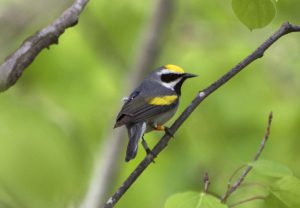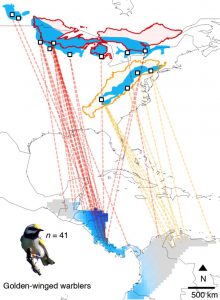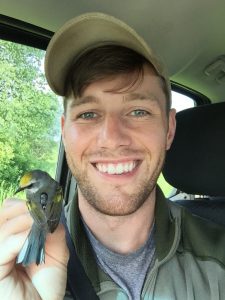Migration research reveals key to declines in rare songbirds
February 27th, 2018 by Christine BillauThe annual long-distance migration of rare, tiny songbirds that reproduce in the Great Lakes region and Appalachian Mountains is no longer a mystery.
By tracking one of the smallest species ever monitored over thousands of miles using cutting-edge technology, a team of ornithologists led by scientists at The University of Toledo found that it is where golden-winged warblers spend the winter in the tropics that determines if a population is declining or stable, not factors associated with the breeding grounds thousands of miles north in the United States and Canada.
 Over the course of the five-year study, the scientists found that different populations of the birds, which are about the size of a ping-pong ball and weigh less than three pennies, do not mix between their separate northern nesting grounds occupied during the spring and summer and the tropical sites where they spend the winter.
Over the course of the five-year study, the scientists found that different populations of the birds, which are about the size of a ping-pong ball and weigh less than three pennies, do not mix between their separate northern nesting grounds occupied during the spring and summer and the tropical sites where they spend the winter.
Mapped using data from 76 light level geolocators recovered from the birds, each population shows strong migratory connectivity, or geographic segregation, that confirms that populations of the birds stay together in different locations for the seasons throughout the year. This strong link between breeding and non-breeding areas means that populations may be exposed to different threats and conditions during the winter.
 According to the study recently published in the Proceedings of the National Academy of Sciences, golden-winged warblers from declining populations spend winters in northern South America. Stable populations of the species spend winters in Central America.
According to the study recently published in the Proceedings of the National Academy of Sciences, golden-winged warblers from declining populations spend winters in northern South America. Stable populations of the species spend winters in Central America.
“They’re separate, and it’s remarkable,” said Gunnar Kramer, PhD student researcher in environmental sciences at UT. “Most species we track like this don’t show strong connections between breeding sites and wintering sites.”
“These golden-winged warblers that breed throughout the Great Lakes region and Appalachian Mountains are going to different areas in the winter,” said Dr. Henry Streby, assistant professor in the UT Department of Environmental Sciences. “That’s pivotal because those tropical areas experienced different rates of forest loss during the last 60 years. When we look at forest-loss rates, it correlates closely with golden-winged warbler population changes on breeding grounds thousands of miles away.”
When it comes to saving the species that is under consideration for federal Endangered Species protection, the researchers say conservationists should switch their focus away from places where their efforts cannot benefit the species and toward restoring habitat and preventing further deforestation in northern Venezuela, “which is, unfortunately, one of the most difficult places to do conservation work in the Americas,” Streby said.
“If the winter habitat keeps disappearing, the warblers that winter in northern South America won’t survive and come back to the Appalachian Mountains no matter how much breeding habitat is available to them,” Streby said.
 Kramer and Streby tracked the birds using the geolocators attached to the birds with tiny backpacks around their legs. Figure-eight harnesses secured the geolocator backpacks, which contained a battery, a computer chip and a light sensor. The whole thing weighs less than half of a paper clip and does not inhibit flight or movement.
Kramer and Streby tracked the birds using the geolocators attached to the birds with tiny backpacks around their legs. Figure-eight harnesses secured the geolocator backpacks, which contained a battery, a computer chip and a light sensor. The whole thing weighs less than half of a paper clip and does not inhibit flight or movement.
“The light sensor records ambient light and stores it with a time stamp on the unit every couple minutes,” Kramer said. “We used differences in day length and changes in how fast dawn and dusk occur to predict daily locations of the birds throughout the year. Based on how long the day and night are and features of the transitions between day and night, you can tell with reasonable accuracy where you are on the planet.”
Unlike other heavier tracking devices, geolocators do not transmit data, so the researchers had to recapture every bird marked with a geolocator and remove the device to recover data.
“Comprehensive studies like this one show the importance of understanding the complex relationships migratory species have with different environments throughout the year and demonstrate that songbirds that spend the summer in our backyards may be experiencing challenging conditions elsewhere that are causing declines,” Kramer said. “These studies also provide information that can immediately be used to start improving conservation efforts, and that’s really exciting.”
The UT researchers collaborated with scientists from several universities and agencies, including the U.S. Geological Survey, University of Tennessee and West Virginia University.
Funding was provided by the U.S. Fish and Wildlife Service, the U.S. Geological Survey and the National Science Foundation.
Tags: College of Natural Sciences and Mathematics
Christine Billau is
UT's Media Relations Specialist. Contact her at 419.530.2077 or christine.billau@utoledo.edu.
Email this author | All posts by
Christine Billau

